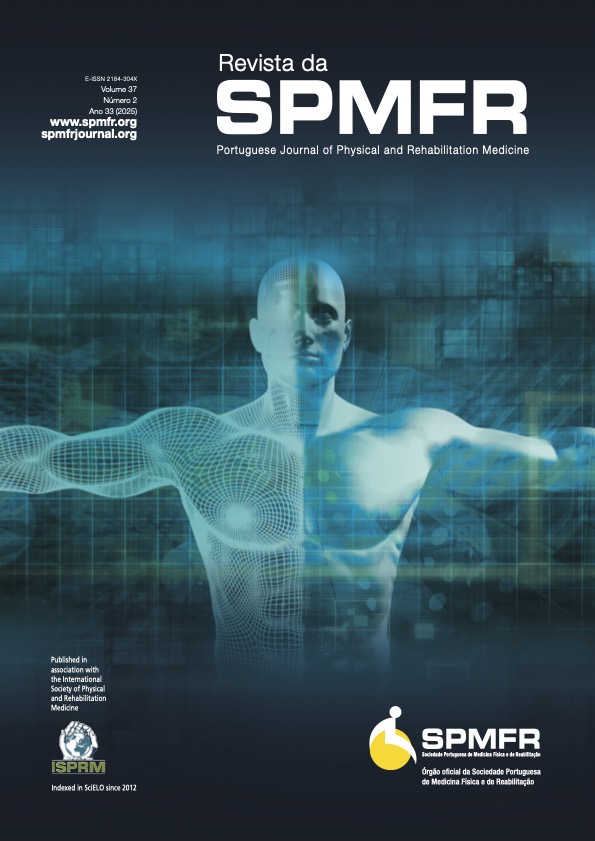Pharmacological Treatment of Neurogenic Erectile Dysfunction: A Narrative Review
DOI:
https://doi.org/10.25759/spmfr.474Keywords:
Neurogenic Erectile Dysfunction, Pharmacological TreatmentAbstract
Erection is a primary event in men’s sexual function, and is particularly valued in this population. Satisfactory sexual function is therefore a key factor for quality of life. Erectile dysfunction is the inability to achieve and/or maintain an erection sufficiently rigid for sexual performance. It may have several aetiologies and is therefore transversal to several medical specialties. Despite being primordial, it continues to be an area frequently undervalued/undertreated, due to the difficulty in approaching it, still usually considered a “taboo” by today’s society. Sexual dysfunction of neurological aetiology, either central or peripheral, is often integrated in the context of complex pathologies, which result in multiple neuro-motor, cognitive-behavioural and functional sequels, with repercussions on the relationship of the patient and/or couple. Due to its importance and as a contributing factor to the individual’s overall functionality and quality of life, sexual function should be valued by the medical team and be an integral part of a holistic approach to the patient. This must consider multiple factors affecting sexual function, beyond the medical condition, including the biopsychosocial context of the individual or couple, their sexual history, beliefs, religion, sexual orientation, comorbidities leading to vascular/endothelial damage, usual medication affecting sexual function, and the psychosocial impact of neurogenic erectile dysfunction. This complexity in the approach and treatment of neurogenic erectile dysfunction makes it a real challenge. Treatment may include a pharmacological and non-pharmacological approach, and information and counselling about the disease are essential strategies. Pharmacological therapy is often included in the medical approach to this pathology and phosphodiesterase type 5 inhibitors have been the most widely used drugs over the past 20 years, due to their safety and efficacy profile. The present article aims to provide an overview of the etiopathogenesis of neurogenic erectile dysfunction, as well as its pharmacological approach.Downloads
References
Kroner RA, Goldstein I, Kirby MG, Parker JD, Sadovsky R. Cardiovascular safety of phosphodiesterase type 5 inhibitors after nearly 2 decades on the market. Sex Med Rev. 2018;6(4):583-94. doi:10.1016/j.sxrm.2018.03.008
Bruzziches R, Francomano D, Gareff P, Lenzl A, Aversa A. An update on pharmacological treatment of erectile dysfunction with phosphodiesterase type 5 inhibitors. Expert Opin Pharmacother. 2013;14(10):1333-44. doi:10.1517/14656562.2013.79966
McMahon CG. Current diagnosis and management of erectile dysfunction. Med J Aust. 2019;21(10):469-76. doi:10.5694/mja2.50167
Diaconu CC, Manea M, Marcu DR, Socca B, Spinu AD, Braiu OG. Erectile dysfunction as a marker of cardiovascular disease: a review. Acta Cardiol. 2020;75(4):286-92. doi:10.1080/00015385.2019.1590498
Thomas C, Konstantinidis C. Neurogenic erectile dysfunction: where do we stand? Medicines. 2021;8(1):3. doi:10.3390/medicines8010003
Shridharani AN, Brant WO. The treatment of erectile dysfunction in patients with neurogenic disease. Transl Androl Urol. 2016;5(1):88-101. doi:10.3978/j.issn.2223-4683.2016.01.07
Del Popolo G, Cito G, Gemma L, Natali A. Neurogenic sexual dysfunction treatment: a systematic review. Eur Urol Focus. 2020;6(4):868-76. doi:10.1016/j.euf.2019.12.002
Denys P, Charlier-Kastler E, Even A, Joussain C. How to treat neurogenic bladder and sexual dysfunction after spinal cord lesion. Rev Neurol (Paris). 2021;177(5):589-93. doi:10.1016/j.neurol.2020.07.013
Calabrio RS, Polimeni G, Bramanti P. Recent advances in the treatment of neurogenic erectile dysfunction. Recent Pat CNS Drug Discov. 2014;9(1):41-53. doi:10.2174/221279840666140131122641
Fenstermaker M, Dupree JM, Hadj-Moussa M, Ohl DA. Management of erectile dysfunction and infertility in the male spinal cord injury patient. Curr Urol Rep. 2018;19(7):47. doi:10.1007/s11934-018-0806-z
Affert L, Pannek J, Burnett AL, Razename C, Tzanoulirou S, Bobela W, et al. Performance and safety of treatment options for erectile dysfunction in patients with spinal cord injury: a review of the literature. Andrology. 2020;8(6):1660-73. doi:10.1111/andr.12878
Lombardi G, Musco S, Wyndaele JJ, Del Popolo G. Treatments for erectile dysfunction in spinal cord patients: alternatives to phosphodiesterase type 5 inhibitors? A review study. Spinal Cord. 2015;53(12):849-54. doi:10.1038/sc.2015.137
Pechorro PS, Calvinho AM, Pereira NM, Veira RX. Validação de uma versão portuguesa do Índice Internacional de Função Erétil-5 (IIEF-5). Rev Int Androl. 2011;9(1):3-9. doi:10.1016/S1689-031X(11)70002-4
Graça B. Índice Internacional da Função Erétil: protagonista na disfunção erétil. Acta Urológica. 2008;25(9):45-7.
Moussa M, Papatsoris AG, Abou Chakra M, Dabboucy B, Fares Y. Erectile dysfunction in common neurological conditions: a narrative review. Arch Ital Urol Androl. 2020;92(4):371-6. doi:10.4081/aiua.2020.4.371
Hong JH, Kwon YS, Kim IV. Pharmacodynamics, pharmacokinetics and clinical efficacy of phosphodiesterase-5 inhibitors. Expert Opin Drug Metab Toxicol. 2017;13(2):183-92. doi:10.1080/17425255.2017.1244265
Yuan J, Zhang RJ, Yang Z, Lee J, Liu Y, Tian J, et al. Comparative effectiveness and safety of oral phosphodiesterase type 5 inhibitors for erectile dysfunction: a systematic review and network meta-analysis. Eur Urol. 2013;63(5):902-12. doi:10.1016/j.sxrm.2013.01.012
Yafi FA, Sharip ID, Becher EF. Update on the safety of phosphodiesterase type 5 inhibitors for the treatment of erectile dysfunction. Sex Med Rev. 2018;6(2):242-52. doi:10.1016/j.sxrm.2017.08.001
Zucchi A, Costantini E, Scroppo FI, Silvani M, Kopa Z, Illiano E, et al. The first-generation phosphodiesterase 5 inhibitors and their pharmacokinetic issue. Andrology. 2019;7(6):804-17. doi:10.1111/andr.12683
Yafi FA, Sharip ID, Becher EF. Update on the safety of phosphodiesterase type 5 inhibitors for the treatment of erectile dysfunction. Sex Med Rev. 2017;5(4):529-39. doi:10.1016/j.sxrm.2017.08.001
Diaconu CC, Manea M, Marcu DR, Socca B, Spinu AD, Braiu OG. Erectile dysfunction as a marker of cardiovascular disease: a review. Acta Cardiol. 2020;75(4):286-92. doi:10.1080/00015385.2019.1590498
Hatzimountidis K, Salonia A, Adalkan G, Buvat J, Carrier S, El-Meliegy A, et al. Pharmacotherapy for erectile dysfunction: recommendations from the Fourth International Consultation for Sexual Medicine. J Sex Med. 2016;13(4):465-88. doi:10.1016/j.jssm.2016.01.016
Downloads
Published
How to Cite
Issue
Section
License
Copyright (c) 2025 Revista da Sociedade Portuguesa de Medicina Física e de Reabilitação

This work is licensed under a Creative Commons Attribution-NonCommercial-NoDerivatives 4.0 International License.
Copyright statement
Authors must also submit a copyright statement (as seen below) on article submission.
To the Editor-in-chief of the SPMFR Journal:
The below signed author(s) hereby state that the article
________________________________________ (ref. MFR_________) is
an original unpublished work and all facts stated are a product of the author(s) investigation. This article does not violate any copyright laws or privacy statements. The author(s) also hereby confirm that there is no conflict of interest's issues in this article.
By submitting this article the author(s) agree that after publication all copyrights belong to the SPMFR Journal.
Signed by all authors
Date:
Names (capital letters):
Signatures:
The SPMFR Journal’s contents are follow a Creative Commons licence. After publication the authors can hand out the articles as long as the SPMFR Journal is credited.



